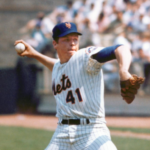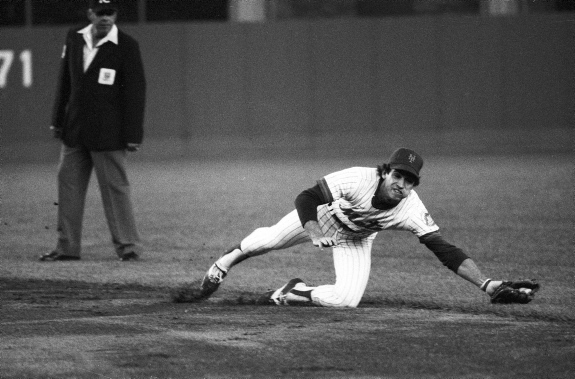
I was 12 years old in the summer of 1978 when I heard the coolest news ever… My friend Lee called and told me he’d heard from a friend of a friend who knew where Mets second baseman Doug Flynn lived. And it was just down the street from me!
True, this wasn’t Jerry Koosman or Steve Henderson or Craig Swan. But it still was a real live Mets player.
Lee and I both lived in Bayside and Doug Flynn (supposedly) lived in the middle of three buildings that neighborhood kids referred to as ‘The Towers’ right off the Cross Island Parkway overlooking Little Neck Bay.
Lee had heard that Flynn lived on the 14th floor but didn’t know the exact apartment number. The two of us spent a day forging a plan. How would we find out which exact apartment? How would we get passed the doorman?
The following day we put our plan into action. It was one of the only times in my youth I went out without my Mets hat. I didn’t want to give myself away and spoil our flawlessly devised plot.
“What do you kids want?” asked the burly doorman, eying us suspiciously.
“I’m looking for a friend of mine who lives here,” I said, scanning the endless sea of names in the tenant’s directory.
I thought it was pretty clever…until he replied, “Oh, yea? What’s his name?”
Uh oh. “We can’t remember,” Lee responded as I continued checking the resident listing. I didn’t see “D. Flynn” anywhere.
With that, we were told to get our you-know-what off the property. Well, so much for meeting a Met. However, one name I caught a glimpse of was “S. Woods” in apt 14-K. As Lee and I regrouped we decided that had to be him. A code name. Woods. What are benches made of? Wood. And who was the Cincinnati catcher Doug Flynn played with before coming to NY as part of the Tom Seaver trade? Yep, Johnny Bench. It was all coming together. The extra proof was the apt #. 14-K. K…as in strikeout. Coincidence? I think not.
We spent the afternoon attempting different ways to bypass the doorman. (Doesn’t this guy ever take a break?) We offered to help little old ladies inside with their packages so we could gain access. We looked for a way to climb the fence into the pool area. A back door? A laundry room? Something???
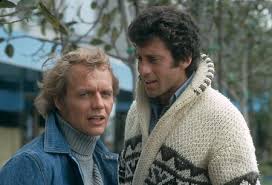 We snuck into the underground parking lot, exhaust fumes filling our lungs. Occasionally we’d get sidetracked by our own imagination, making guns with our hands as we darted between parked cars and “shot” at each other like we were Starsky and Hutch.
We snuck into the underground parking lot, exhaust fumes filling our lungs. Occasionally we’d get sidetracked by our own imagination, making guns with our hands as we darted between parked cars and “shot” at each other like we were Starsky and Hutch.
Then, it dawned on me. Even if we did manage to meet “S. Woods,” aka Doug Flynn, what would we say? I mean, Lee was 13, I was 12. And Doug Flynn was a real live major leaguer.
Our plan failed. We never got to meet the mystery resident in 14-K.
A few days later I was riding in my elevator. An elderly neighbor with white hair who stood at four foot nothing casually mentioned to another passenger, “I was having breakfast in the coffee shop in Bay Terrace yesterday and guess who was sitting across from me? Doug Flynn.”
I was shocked, flabbergasted. The only thing I could think of to say was, “What did he eat?”
“Bacon and eggs,” Miriam responded.
Bacon and eggs? This was a letdown. Bacon and eggs? I eat bacon and eggs, too. Surely, being a professional ballplayer he should be eating different food than me. Maybe even some baseball-related food, like a hot dog. Or Cracker Jacks. But no, Doug Flynn, professional major leaguer, was just like me.
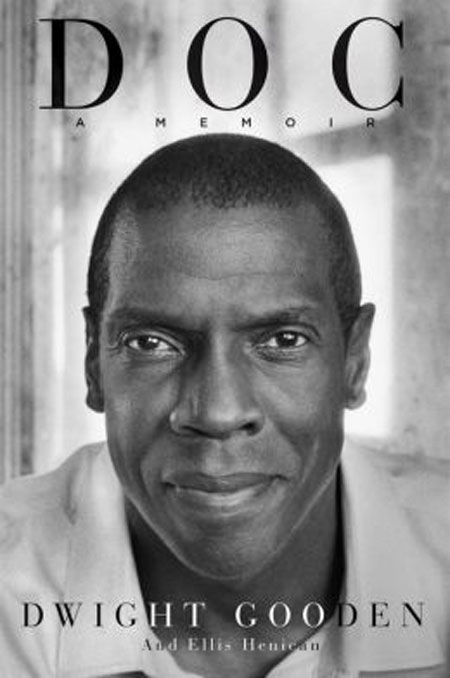 A few days ago I concluded reading “Doc: A Memoir” by Dwight Gooden and Ellis Henican. That 12 year old kid scampering around an underground garage like Starsky is a fading memory. But after reading Doc’s memoir, I was once again reminded that ballplayers are people, too. They have issues to deal with. They have families. They eat bacon and eggs.
A few days ago I concluded reading “Doc: A Memoir” by Dwight Gooden and Ellis Henican. That 12 year old kid scampering around an underground garage like Starsky is a fading memory. But after reading Doc’s memoir, I was once again reminded that ballplayers are people, too. They have issues to deal with. They have families. They eat bacon and eggs.
We come home from our jobs, turn on a ballgame and watch others do their job. We venture out to Flushing to escape our own lives for a few hours to watch others work. But those guys down on that field are people just like us.
Okay, maybe not exactly like us. While I still have some moderate success in the batting cages at my local miniature golf course, I’m not exactly David Wright. When Dwight Gooden, star pitcher of the Mets, walked into a Strip Club in the 80’s, his fame and popularity opened the door to going home with a few strippers.
Me? While I love writing for this site, when I advise a stripper, “I’m a blogger for Metsmerized,” I don’t get the same result as Doc did. Instead, I get an arched eyebrow, a curious look and, “Look, dude, do you want this lap dance or not?” So, yes, I guess ballplayers are a little different in some ways.
Joe reviewed this book a few weeks back and did a far better job that I ever could. I found Doc’s memoir to be painful, disturbing. A tough read. But also inspiring. I read the nearly 300 pages in three sittings, stopping every once in a while to let some of what I just read ‘sink in.’
If you’re looking for a “baseball book” this is not it. If you’re hoping for a behind-the-scenes tell-all into the boozing, brawling and bimbo-chasing bad boys of 1986, this is not for you. The entire glorious 86 season is summed up in one chapter. Game Six gets 2 paragraphs.
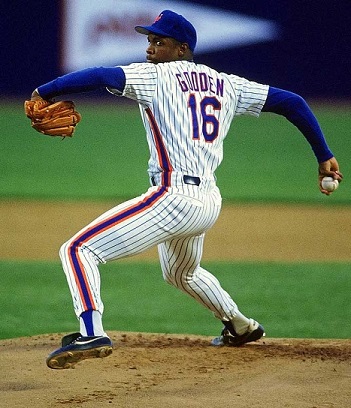 This is not about the great Doctor K–Rookie of the Year, Cy Young winner, starter of an All-Star game and surefire lock for Cooperstown. This is a book about Dwight Eugene Gooden, a man possessed by the demons of addiction—who just happened to be a baseball player.
This is not about the great Doctor K–Rookie of the Year, Cy Young winner, starter of an All-Star game and surefire lock for Cooperstown. This is a book about Dwight Eugene Gooden, a man possessed by the demons of addiction—who just happened to be a baseball player.
Not many of us now first-hand what it’s like to be a baseball player. It’s not like we have family members or second cousins who play. However, many of us do have a close relationship to addiction. How many people reading this knows someone—a friend, family member—who battles some sort of addiction, be it alcohol, substance abuse, gambling, etc…While it’s difficult to relate to a “baseball player” it’s easier to relate to someone waging an internal struggle to NOT reach for that beer, to NOT do that line of Coke.
As I read this painful but moving story of a man’s life, a man who battled addiction brought on by a painful childhood and untold wealth, fame and popularity by being the top sports figure in the biggest city in America, I felt myself humbled. While reading this excellent work of non-fiction, at times I laughed. Other times, I was reminded of things I’d forgotten. I felt my blood boiling as Dwight recounted the way he was treated by prison intake guards during one of his incarcerations. And yes, I shed a few tears.
I even—as hard as this is to believe—gained a new respect for George Steinbrenner. I never thought I’d say this (or write this) but ‘King George’ was a class act.
In his words I found Dwight to be honest, humble, forthright and direct. He opened his heart and bared his soul for the entire world to see. He doesn’t make excuses for what he did. He doesn’t point fingers like that other player from the Mets he is frequently associated with. He accepts responsibility.
In Dwight’s blunt self-assessment of his life and his career, the words he uses leave no doubt. He is a man filled with sorrow. Not just for the heartache he brought upon his children, his wife, his parents, his family. But also for us Mets fans. You can’t help but get the feeling he is filled with guilt and regret. Dwight was 19 when he arrived in New York. A kid. But old enough to realize the hopes of an entire city rested on his teenage shoulder and in his teenage arm.
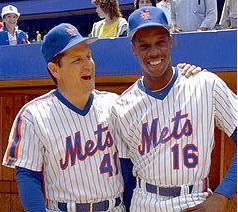
When Mets fans look back at the Dynasty that never was, it seems we view Doc as the poster child for everything that went wrong. I, too, had unfairly blamed him as one of the reasons.
I now feel it’s necessary NOT to blame Doc for what didn’t happen in the 80’s but to thank him for what he gave us.
In the summer of 91, my wife and I were living in Philly for a short time. One Saturday afternoon we drove up the Jersey Turnpike, across the Bronx and walked into Shea. The Mets were playing the Giants that day. As we sat in the mezzanine level along third base, I leaned over, tapped her on the shoulder and pointed to #16 on the mound. “One day,” I said, “we’ll be able to tell our grandkids that we saw the great Doc Gooden pitch.” We never had kids, grandkids and a decade later the marriage itself ended. But I did get to see the great Doc Gooden pitch.
I was too young to really appreciate the greatness I witnessed when Tom Seaver took the mound. And while Matt Harvey is a hell of a pitcher, he still has a ways to go. I can, however, confidently state that in forty years of rooting for the Mets I never—NEVER—saw a pitcher dominate a game the way he did.
By the time I finished reading this book, I was worn out. Reading about the roller coaster he endured left me physically drained. I can’t begin to imagine what it was like for him.
In the 80’s, I found myself cheering for Doctor K, Doc Gooden.
Now, in something that’s ultimately more important than defeating the Cubs or Cardinals, I found myself cheering for Dwight Eugene Gooden. Not the prodigy, not the young star who would lead a baseball franchise out of the dark wilderness. Rather a man, a human being, who learned and made me once again realize that sometimes the game of life is more important than the game of Baseball.
I’ve always been a fan of Doc. Now I’m a fan of Dwight.
WIN A FREE SIGNED COPY OF DOC!
You can purchase a copy of DOC: A Memoir for less than the price of a nosebleed seat at good ol’ Shea. Or you can follow us on Twitter at @Metsmerized for a chance to win a FREE Signed Edition of Doc during tonight’s All Star Game.
Just tweet us your favorite Doctor K moment and include the hashtag #DocGooden




